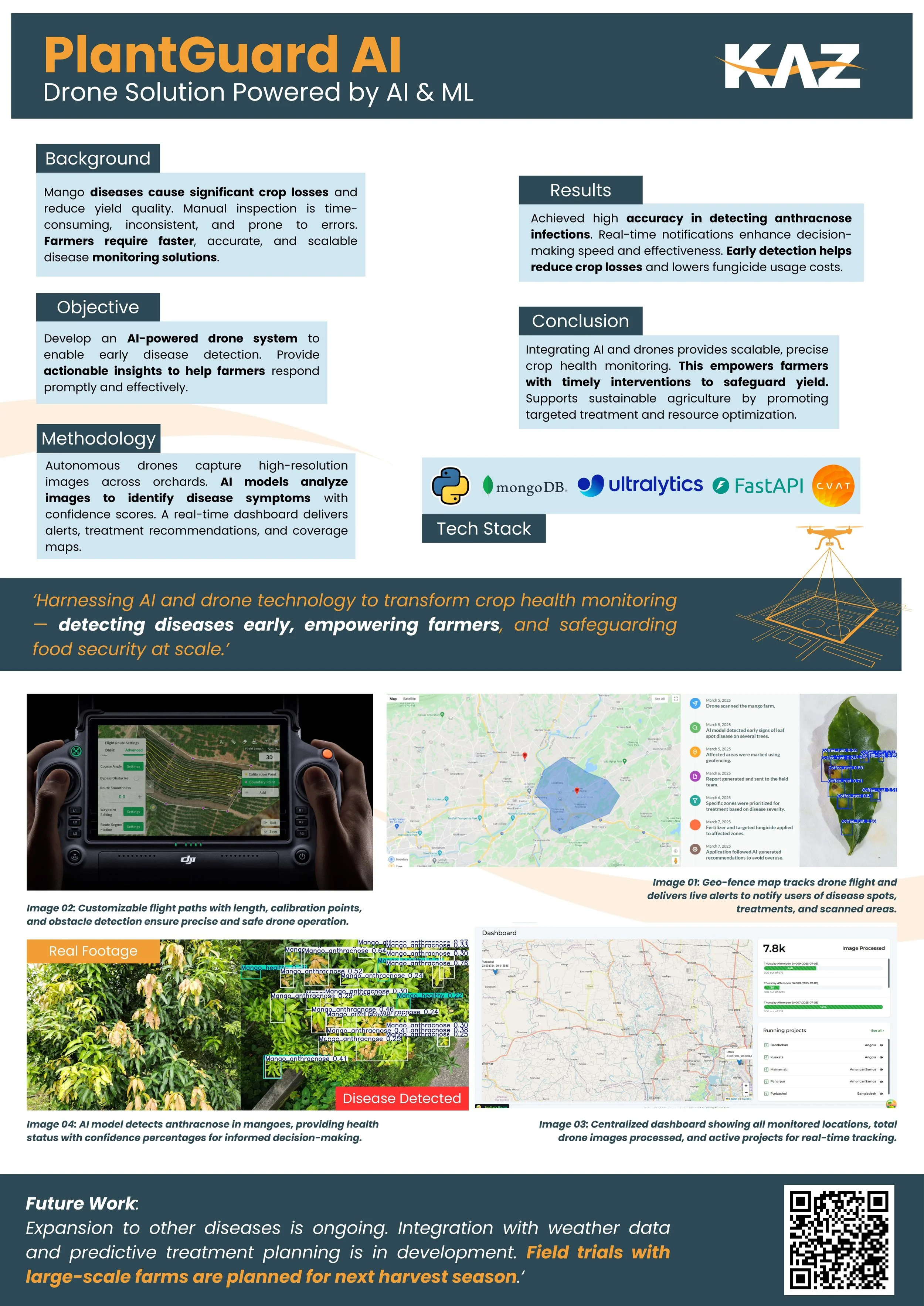How Drones Are Quietly Reshaping Agriculture
/Precision agriculture is being transformed by AI-powered drones that enable early plant disease detection and reduce pesticide dependency.
AI-powered drones are transforming modern farming with early disease detection, precision spraying, and real-time crop insights. Discover how PlantGuard AI leads this quiet revolution in agri-tech.
From Manual Labor to Drone Precision
For generations, farmers have relied on walking their fields—spraying crops by hand, inspecting plants with their eyes, and reacting only once damage is visible. It’s a system that has persisted out of necessity, not efficiency. But a new era is rising silently above those fields—powered by drones.
Autonomous drones are rapidly replacing the need for physical presence in harsh agricultural environments. What used to take an entire day of manual spraying can now be completed in less than an hour, with higher accuracy and less chemical exposure. Traditional backpack sprayers often result in blanket spraying—wasting chemicals, increasing costs, and harming both the environment and the farmer’s health. In contrast, drones deliver precision.
GPS-guided flight paths allow drones to spray only where needed. Terrain no longer limits access. Hard-to-reach patches, rugged landscapes, or uneven orchards can now be treated with the same level of detail and care as open fields. In countries like China and Japan, drones are already spraying up to 60% of cultivated land, a trend that's accelerating globally.
The shift isn't just about saving time—it's about changing how agriculture is practiced. This isn't automation for the sake of it; it's automation that makes farming safer, faster, and smarter.
Agri-Drones Are Fueling a Billion-Dollar Industry
The agriculture drone market is booming. What stood at $5 billion globally in 2023 is expected to reach over $18 billion by 2030, growing at more than 20% CAGR. This isn't just hype—it’s a reflection of real-world adoption, where drones are becoming essential tools rather than experimental tech.
In East Asia, drones are already commonplace. China's agricultural drone fleets sprayed over 150 million acres in a single year. India is pushing national drone programs to support its massive agrarian population. And in the United States, research centers like Ohio State University are training farmers and agri-tech entrepreneurs to adopt drones for targeted spraying and smart monitoring.
With the agricultural drone market set to reach over $18 billion by 2030 and adoption rates climbing across Asia and North America, drone diagnostics are no longer niche—they’re essential.
Why the rapid uptake? Because drones solve real problems—efficient use of fertilizers and pesticides, reduced labor dependency, and scalable crop management. But as adoption rises, expectations grow. It’s no longer enough for drones to simply spray. Today’s agri-tech needs data, diagnostics, and decisions—all in real time.
That's where new entrants like PlantGuard AI fit in: not just flying machines, but flying analysts.
Detecting Disease Before It Spreads
Recent research shows that UAV-based remote sensing and deep learning models can detect crop diseases—even before visible symptoms—enabling growers to act faster and smarter.
While most drone solutions focus on distribution—spraying pesticides, fertilizers, or seeds—very few tackle the critical phase before action: detection. Yet in agriculture, the damage from disease often begins long before any visible symptoms appear.
Enter PlantGuard AI: a drone-powered platform that doesn't just fly or spray—it sees, diagnoses, and alerts.
Using high-resolution aerial imagery and AI trained on real-world disease data, the system can detect anthracnose in mangoes before the human eye ever spots it. Instead of waiting for leaves to curl or fruit to rot, PlantGuard AI catches the early signals—microscopic color shifts, canopy pattern changes, and infection markers. This early diagnosis enables treatment within the optimal window, dramatically reducing crop loss and minimizing chemical usage.
Think of it as the difference between firefighting and fire prevention. Most farming interventions are reactive. PlantGuard AI shifts that to proactive—with AI vision that acts like a doctor for your orchard.
PlantGuard AI Is Built for Real-Time Action
Developed by Kaz Software, PlantGuard AI is a practical response to one of agriculture’s most overlooked needs: fast, accurate disease intelligence that scales. It’s not a theoretical lab tool—it’s been deployed in mango orchards across Bangladesh, cutting inspection time and improving fungicide efficiency through early action.
The system is composed of:
Autonomous drones with pre-planned flight paths and obstacle-aware navigation.
A cloud-based AI engine that analyzes each aerial image for signs of disease.
A real-time dashboard that displays disease zones, recommended treatments, and scanning coverage.
Immediate alerts for farmers and agronomists.
Combining real-time aerial imaging, CNNs, and next-gen Vision Transformers, modern drone systems are creating the future of farm monitoring — and PlantGuard AI is right at the center.
And it doesn’t stop with mangoes. The model is extensible—designed to be trained for other crops and diseases. Upcoming versions will integrate weather data and predictive treatment mapping, enabling even smarter, localized interventions.
In a world where climate threats, labor shortages, and food security challenges are converging, solutions like PlantGuard AI provide a lifeline. They take what drones already do well—speed, access, and coverage—and combine it with intelligence. Actionable intelligence.







